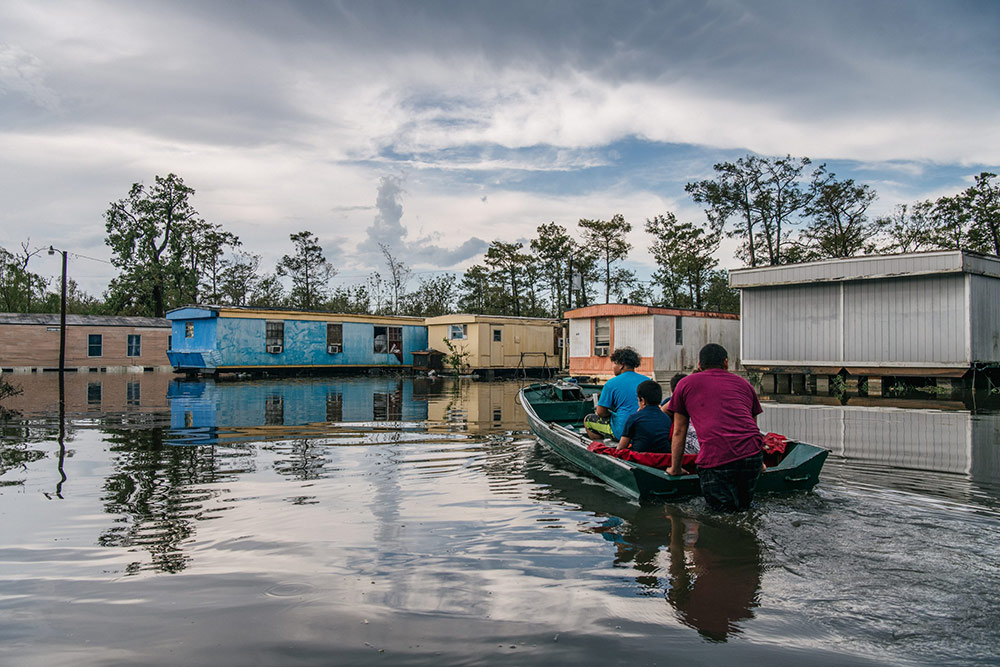
越來越多美國家庭可能因?yàn)闅夂蛳嚓P(guān)災(zāi)難受到傷害,這種風(fēng)險(xiǎn)的嚴(yán)重程度是史無前例的,。2021年,,美國至少發(fā)生了20場造成損失超過10億美元的災(zāi)難,災(zāi)后重建成本總計(jì)超過1,450億美元,。據(jù)估計(jì),,僅颶風(fēng)艾達(dá)造成的經(jīng)濟(jì)損失就達(dá)到950億美元。
極端氣候事件發(fā)生的頻率越來越高,,越來越嚴(yán)重,,但美國的國家減災(zāi)和災(zāi)后重建工作卻并沒有相應(yīng)地加快速度。這種情況不能持續(xù)下去,,而且美國國會和拜登政府有解決這個(gè)問題的方法,。
每當(dāng)爆發(fā)大災(zāi)難,聯(lián)邦應(yīng)急管理署都會提供初步緊急救援,,包括提供短期租房和臨時(shí)維修資金等,。但當(dāng)幸存者走出眼前的危險(xiǎn)境地之后,長期救助就變得遙遙無期,。
美國國會主要通過住房與城市發(fā)展部社區(qū)發(fā)展整筆撥款災(zāi)后恢復(fù)(CDBG-DR)計(jì)劃,,提供居民災(zāi)后恢復(fù)和重建資金,該計(jì)劃可為各縣,、市和州輸送靈活資源,,用于提供貸款和資助,滿足不屬于保險(xiǎn)范圍或聯(lián)邦應(yīng)急管理署覆蓋范圍的重建需求,。
當(dāng)保險(xiǎn)或聯(lián)邦應(yīng)急管理署的資助不足以維修房屋或幫助人們獲得穩(wěn)定的新住房時(shí),,該計(jì)劃就成為滿足這些需求的關(guān)鍵保障。CDBG-DR計(jì)劃尤其注重對低收入社區(qū)的援助,,通常至少70%的資源將使中低收入家庭受益,。
與聯(lián)邦應(yīng)急管理署的災(zāi)后恢復(fù)計(jì)劃不同,CDBG-DR計(jì)劃無法迅速覆蓋社區(qū),,因?yàn)樵撚?jì)劃并沒有獲得永久授權(quán),。這意味著該計(jì)劃首先需要獲得國會批準(zhǔn),,才能向受影響的地區(qū)提供資金。獲得華盛頓批準(zhǔn)只是第一步:CDBG-DR撥款需要經(jīng)過漫長的審批過程,,在此期間,,準(zhǔn)備接收資源的各州和地方必須制定新的資源分配方案和指南。城市研究院(Urban Institute)發(fā)現(xiàn),,CDBG-DR計(jì)劃的資金,,平均需在災(zāi)難發(fā)生后20個(gè)月,才能開始發(fā)放到受影響的業(yè)主手中,。
聯(lián)邦救助的嚴(yán)重延誤,,是一個(gè)不可接受的公平問題。雖然有辦法的業(yè)主可以立即開始維修,,并希望能獲得賠償,,但許多最低收入家庭和有色人種在災(zāi)難中受到的影響更加嚴(yán)重,但卻只能得到最少的援助,,在短期援助計(jì)劃結(jié)束后,,他們將面臨無家可歸的處境,或者被迫搬遷,。
許多家庭因?yàn)闊o法承受沒有盡頭的等待,,于是選擇了搬遷,搬到了沒有經(jīng)濟(jì)保障或社會保障的新社區(qū),。有人雖然利用現(xiàn)有的有限資金開始重建,,但卻沒有資金保證新家能夠抵御未來的災(zāi)難。
應(yīng)對這個(gè)挑戰(zhàn)的解決方案可以分為兩個(gè)方面,。
首先,,國會必須授予CDBG-DR計(jì)劃永久授權(quán)。參眾兩院的國會領(lǐng)袖通過了《災(zāi)難恢復(fù)改革法案》(The Reforming Disaster Recovery Act),,旨在改進(jìn)美國漏洞百出的災(zāi)難恢復(fù)系統(tǒng),。這份兩黨法案將永久授權(quán)CDBG-DR計(jì)劃,更高效,、更公平地將災(zāi)難恢復(fù)資源送到受災(zāi)社區(qū),,改善受災(zāi)家庭的處境。參議員布萊恩·沙茨表示,,這項(xiàng)法案“修改了法律,,讓[受災(zāi)家庭]無需漫長地等待援助。一旦發(fā)生災(zāi)難,,HUD就可以幫助社區(qū)開始恢復(fù),。”
其次,,私人市場應(yīng)該介入,,填補(bǔ)資金缺口,。企業(yè)社區(qū)合作伙伴(Enterprise Community Partners)和摩根士丹利(Morgan Stanley)最近啟動了一個(gè)規(guī)模高達(dá)2,500萬美元的試點(diǎn)項(xiàng)目,旨在驗(yàn)證這個(gè)概念,。該項(xiàng)目的首款產(chǎn)品是為多戶經(jīng)濟(jì)適用房的業(yè)主提供過橋貸款,支持業(yè)主在等待長期援助的過程中,,能夠立即開始恢復(fù)過程,。
我們首先從愛荷華州、路易斯安那州和俄勒岡州開始,。這三個(gè)州在今年秋天可以從國會提供的50億美元資金中獲得聯(lián)邦災(zāi)難恢復(fù)資源,。這類計(jì)劃可以在全國范圍內(nèi)展開,在公共災(zāi)難恢復(fù)資金到位之前,,由私人企業(yè)提供短期資本,,從而縮短災(zāi)難幸存者居住在臨時(shí)住房或受損住房的時(shí)間。
每年,,自然災(zāi)害和氣候沖擊事件變得越來越嚴(yán)重,。曾經(jīng)“數(shù)十年不遇的”風(fēng)暴變得司空見慣。聯(lián)邦資源必須加快發(fā)放速度,,并做到更加公平,。災(zāi)難援助不能等待。
本文作者普里西拉·阿爾莫多瓦現(xiàn)任全國經(jīng)濟(jì)適用房非營利機(jī)構(gòu)企業(yè)社區(qū)合作伙伴的總裁兼首席執(zhí)行官,。(財(cái)富中文網(wǎng))
譯者:劉進(jìn)龍
審校:汪皓
越來越多美國家庭可能因?yàn)闅夂蛳嚓P(guān)災(zāi)難受到傷害,,這種風(fēng)險(xiǎn)的嚴(yán)重程度是史無前例的。2021年,,美國至少發(fā)生了20場造成損失超過10億美元的災(zāi)難,,災(zāi)后重建成本總計(jì)超過1,450億美元。據(jù)估計(jì),,僅颶風(fēng)艾達(dá)造成的經(jīng)濟(jì)損失就達(dá)到950億美元,。
極端氣候事件發(fā)生的頻率越來越高,越來越嚴(yán)重,,但美國的國家減災(zāi)和災(zāi)后重建工作卻并沒有相應(yīng)地加快速度,。這種情況不能持續(xù)下去,而且美國國會和拜登政府有解決這個(gè)問題的方法,。
每當(dāng)爆發(fā)大災(zāi)難,,聯(lián)邦應(yīng)急管理署都會提供初步緊急救援,包括提供短期租房和臨時(shí)維修資金等,。但當(dāng)幸存者走出眼前的危險(xiǎn)境地之后,,長期救助就變得遙遙無期。
美國國會主要通過住房與城市發(fā)展部社區(qū)發(fā)展整筆撥款災(zāi)后恢復(fù)(CDBG-DR)計(jì)劃,,提供居民災(zāi)后恢復(fù)和重建資金,,該計(jì)劃可為各縣,、市和州輸送靈活資源,用于提供貸款和資助,,滿足不屬于保險(xiǎn)范圍或聯(lián)邦應(yīng)急管理署覆蓋范圍的重建需求,。
當(dāng)保險(xiǎn)或聯(lián)邦應(yīng)急管理署的資助不足以維修房屋或幫助人們獲得穩(wěn)定的新住房時(shí),該計(jì)劃就成為滿足這些需求的關(guān)鍵保障,。CDBG-DR計(jì)劃尤其注重對低收入社區(qū)的援助,,通常至少70%的資源將使中低收入家庭受益。
與聯(lián)邦應(yīng)急管理署的災(zāi)后恢復(fù)計(jì)劃不同,,CDBG-DR計(jì)劃無法迅速覆蓋社區(qū),,因?yàn)樵撚?jì)劃并沒有獲得永久授權(quán)。這意味著該計(jì)劃首先需要獲得國會批準(zhǔn),,才能向受影響的地區(qū)提供資金,。獲得華盛頓批準(zhǔn)只是第一步:CDBG-DR撥款需要經(jīng)過漫長的審批過程,在此期間,,準(zhǔn)備接收資源的各州和地方必須制定新的資源分配方案和指南,。城市研究院(Urban Institute)發(fā)現(xiàn),CDBG-DR計(jì)劃的資金,,平均需在災(zāi)難發(fā)生后20個(gè)月,,才能開始發(fā)放到受影響的業(yè)主手中。
聯(lián)邦救助的嚴(yán)重延誤,,是一個(gè)不可接受的公平問題,。雖然有辦法的業(yè)主可以立即開始維修,并希望能獲得賠償,,但許多最低收入家庭和有色人種在災(zāi)難中受到的影響更加嚴(yán)重,,但卻只能得到最少的援助,在短期援助計(jì)劃結(jié)束后,,他們將面臨無家可歸的處境,,或者被迫搬遷。
許多家庭因?yàn)闊o法承受沒有盡頭的等待,,于是選擇了搬遷,,搬到了沒有經(jīng)濟(jì)保障或社會保障的新社區(qū)。有人雖然利用現(xiàn)有的有限資金開始重建,,但卻沒有資金保證新家能夠抵御未來的災(zāi)難,。
應(yīng)對這個(gè)挑戰(zhàn)的解決方案可以分為兩個(gè)方面。
首先,,國會必須授予CDBG-DR計(jì)劃永久授權(quán),。參眾兩院的國會領(lǐng)袖通過了《災(zāi)難恢復(fù)改革法案》(The Reforming Disaster Recovery Act),旨在改進(jìn)美國漏洞百出的災(zāi)難恢復(fù)系統(tǒng),。這份兩黨法案將永久授權(quán)CDBG-DR計(jì)劃,,更高效,、更公平地將災(zāi)難恢復(fù)資源送到受災(zāi)社區(qū),改善受災(zāi)家庭的處境,。參議員布萊恩·沙茨表示,,這項(xiàng)法案“修改了法律,讓[受災(zāi)家庭]無需漫長地等待援助,。一旦發(fā)生災(zāi)難,,HUD就可以幫助社區(qū)開始恢復(fù)?!?/p>
其次,私人市場應(yīng)該介入,,填補(bǔ)資金缺口,。企業(yè)社區(qū)合作伙伴(Enterprise Community Partners)和摩根士丹利(Morgan Stanley)最近啟動了一個(gè)規(guī)模高達(dá)2,500萬美元的試點(diǎn)項(xiàng)目,旨在驗(yàn)證這個(gè)概念,。該項(xiàng)目的首款產(chǎn)品是為多戶經(jīng)濟(jì)適用房的業(yè)主提供過橋貸款,,支持業(yè)主在等待長期援助的過程中,能夠立即開始恢復(fù)過程,。
我們首先從愛荷華州,、路易斯安那州和俄勒岡州開始。這三個(gè)州在今年秋天可以從國會提供的50億美元資金中獲得聯(lián)邦災(zāi)難恢復(fù)資源,。這類計(jì)劃可以在全國范圍內(nèi)展開,,在公共災(zāi)難恢復(fù)資金到位之前,由私人企業(yè)提供短期資本,,從而縮短災(zāi)難幸存者居住在臨時(shí)住房或受損住房的時(shí)間,。
每年,自然災(zāi)害和氣候沖擊事件變得越來越嚴(yán)重,。曾經(jīng)“數(shù)十年不遇的”風(fēng)暴變得司空見慣,。聯(lián)邦資源必須加快發(fā)放速度,并做到更加公平,。災(zāi)難援助不能等待,。
本文作者普里西拉·阿爾莫多瓦現(xiàn)任全國經(jīng)濟(jì)適用房非營利機(jī)構(gòu)企業(yè)社區(qū)合作伙伴的總裁兼首席執(zhí)行官。(財(cái)富中文網(wǎng))
譯者:劉進(jìn)龍
審校:汪皓
More American homes are at a greater risk of harm from weather-related disasters than at any point in our history. In 2021, the U.S. recorded at least 20 disasters that cost $1 billion or more in losses, totaling more than $145 billion in recovery costs. Estimates pegged the damage from Hurricane Ida at $95 billion—just for one single storm.
The frequency and severity of extreme weather events are increasing, but our national disaster mitigation and recovery efforts are not accelerating at even close to the same pace. This cannot continue–and Congress and the Biden-Harris administration have the tools to fix it.
When major disasters strike, FEMA steps in to provide initial emergency aid, including offering funds for basic short-term rental housing and temporary repairs. But once disaster survivors are out of immediate danger, the wait begins for long-term help.
Congress provides funding for residential disaster recovery and rebuilding efforts primarily through the Department of Housing and Urban Development’s Community Development Block Grant-Disaster Recovery (CDBG-DR) program, which funnels flexible resources to counties, cities, and states to provide loans and grants to address rebuilding needs not already covered by insurance or FEMA.
CDBG-DR has become a critical safeguard for filling any unmet needs if insurance proceeds and FEMA grants are insufficient to repair homes or get families to stable new housing. CDBG-DR particularly aids lower-income communities, with a typical program dedicating at least 70% of its resources to benefit low and moderate-income families.
Unlike FEMA’s disaster recovery programs, CDBG-DR cannot reach communities quickly because it is not permanently authorized. This means Congress must vote to approve its use before funds can be made available to impacted jurisdictions. The green light from Washington is only the first step: A CDBG-DR appropriation kicks off a lengthy approval process during which states and local jurisdictions that are set to receive resources must develop new programs and guidelines to distribute them. The Urban Institute found that it takes an average of 20 months after a disaster for CDBG-DR funds to begin reaching impacted property owners.
Such an extreme delay in federal relief is an unacceptable equity issue. While property owners with the means can start making repairs immediately and hope for reimbursement, many of the lowest-income households and people of color–who are disproportionately affected by disasters but receive the least amount of assistance–face homelessness or displacement when shorter-term assistance programs end.
Many families who cannot afford the indefinite waiting period start over elsewhere, moving to new communities without financial or social safety nets. Others use the limited funds they have on hand to rebuild, but often lack the capital to ensure their new homes are fortified against future disasters.
The solution to this challenge is twofold.
First, Congress must permanently authorize CDBG-DR. Congressional leaders in the House and Senate introduced The Reforming Disaster Recovery Act to ameliorate America’s ailing disaster recovery system. The bipartisan bill would permanently authorize the CDBG-DR program and improve outcomes for families by getting recovery resources to disaster-stricken communities in a more efficient and equitable way. This bill, according to Senator Brian Schatz, “changes the law so [families] no longer have to wait. As soon as a disaster strikes, HUD can help communities begin the process of recovery.”
Second, the private market should step in to provide financing to fill the gap. Enterprise Community Partners and Morgan Stanley recently launched a $25 million pilot program to prove this concept. This first-of-its-kind product will provide owners of multifamily affordable housing properties bridge loans to start the recovery process immediately while waiting for long-term assistance.
We are starting with Iowa, Louisiana, and Oregon, three of the states selected to receive federal disaster recovery resources from the five billion dollars Congress made available in the fall. Initiatives like this can be scaled nationwide, so that the private sector provides short-term capital until public recovery dollars arrive, shortening the time that survivors live in temporary or damaged housing.
Natural disasters and climate shocks are growing more severe with each passing year. Storms that were once considered “once in a generation” have become the norm. Federal resources must move faster–and more equitably–to keep pace. This cannot wait.
Priscilla Almodovar is president and chief executive officer of Enterprise Community Partners, a national affordable housing nonprofit.






